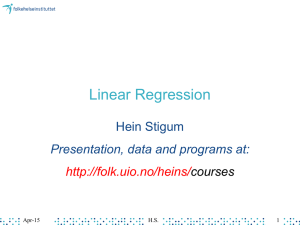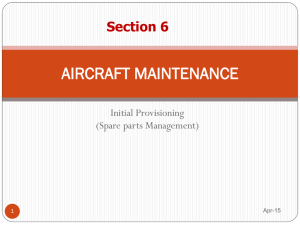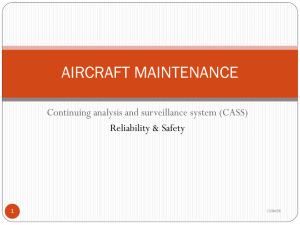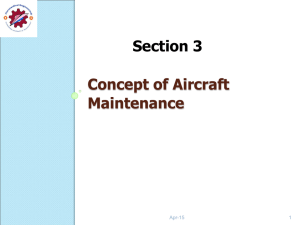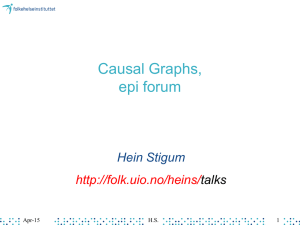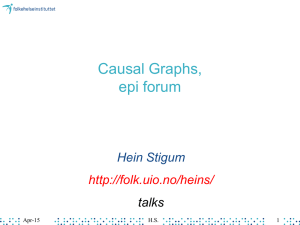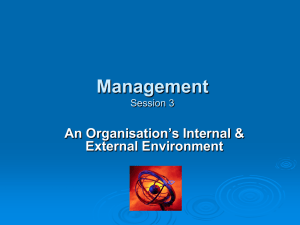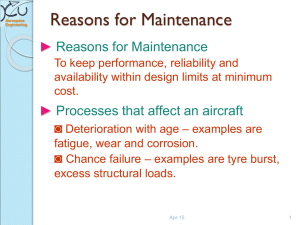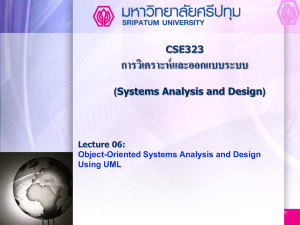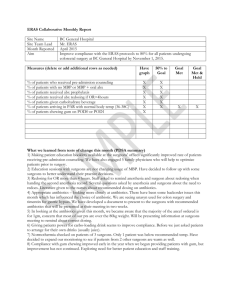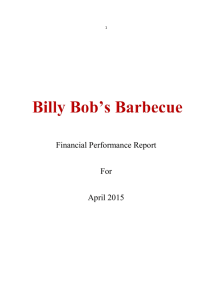Uncertainty – How Much Don`t We Know?
advertisement
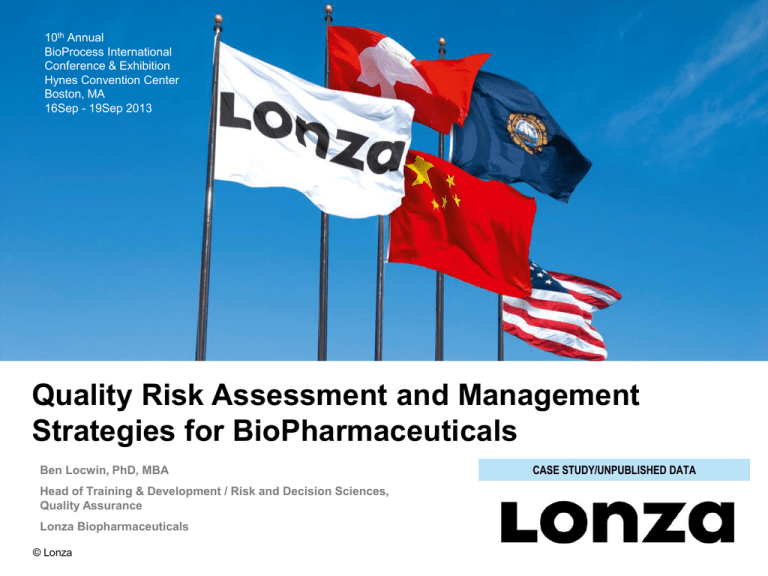
10th Annual Pharma&Biotech BioProcess International Conference & Exhibition Hynes Convention Center Boston, MA 16Sep - 19Sep 2013 Quality Risk Assessment and Management Strategies for BioPharmaceuticals Ben Locwin, PhD, MBA Head of Training & Development / Risk and Decision Sciences, Quality Assurance Lonza Biopharmaceuticals © Lonza CASE STUDY/UNPUBLISHED DATA Risk Analysis – A Brief Primer Where does risk assessment come from? Why is it important? What is the overall utility? 2 Apr-15 Why Do We Need Formal Tools? We’re human! We have fallibilities and produce errors when trying to estimate likelihoods and outcomes “We often think that when we have completed our study of “one” we know all about “two,” because “two” is “one and one.” We forget that we still have to make a study of “and.” -- Sir Arthur Eddington 3 Apr-15 Different Types of Cultures Immature vs. Mature risk-view cultures NOT termed “-averse” or “-seeking” here for a reason 4 Apr-15 Loss Analysis What is the theory? To get a better handle on risk! R = Pf x M c How likely is it? How big is it? Uncertainty in Risk Uncertainty in estimates makes us less confident in our decisions The “uncertainty path” of a hurricane shows visually how much we don’t know More information could make a big difference Magnitude in Risk Magnitude gives us an estimate of the potential size of the outcome Hindsight would have us avoiding or preventing all catastrophes (not possible!) Very low probability, high magnitude events (Black Swan events) shape our world Hazard-Loss Estimation Any serious evaluation of risk takes into account the following four factors: 1. Hazard 2. Inventory 3. Vulnerability 4. Loss A hazard’s potential impact on inventory is the inherent vulnerability The vulnerability of the inventory gives a sense of the magnitude of loss Active Advancement of Risk Methods JPL – for Optimal Mars Entry, Descent, and Landing Optimal sequential decisions within a specified risk bound Not standard dynamic programming (achieves risk aversion by arbitrary penalties on failure states) Instead uses “risk allocation” (RC-DP) to decompose a joint chance into a set of individual chance constraints and distributes risk over them. Reference: Ono, M. and Kuwata, Y. (2013). NASA Tech Briefs. Information Technology, 37(7), 52. 9 Apr-15 Further Extraterrestrial Example Paths over Martian terrain NO DIFFERENT from paths through our latent risks! .72 .38 .07 .81 .80 .40 Overall certainty diminishes .28 .10 .45 10 Apr-15 Reference: Jet Propulsion Laboratory. (2013). Covariance Analysis Tool (G-CAT) for Computing Ascent, Descent, and Landing Errors. Software Tech Briefs. 11 Apr-15 Probability-Impact Matrix First tool: Assess at a high-level with a probability-impact matrix Uses horizontal resolution to maximum effect 3 x 3 matrix can blur risks 12 Apr-15 OT-Matrix This matrix layout does not overlook opportunities in the interest of threats (which is typical) P P I I 13 Apr-15 Ask “Why?” 7 ±2 Times to Get to Needed Action Second tool: Understand the depth with 5 Whys 14 Apr-15 Fishbone Diagram Third tool: Assess cause-and-effect structure with a Fishbone Diagram 15 Apr-15 Contradiction Matrix (Is/Is Not Analysis) Fourth tool: Disambiguate with a Contradiction Matrix 16 Apr-15 FMEA Fifth tool: Prioritize risks with Failure Modes and Effects Analysis Caveat: It’s not a tool for every risk assessment – beware the Concreteness Fallacy Sometimes with many factors and multiplicative scores, a weighted decision matrix (e.g., Pugh) works much better 17 Apr-15 Fallacies and Pitfalls The Manager’s Fallacy The Buyer’s Fallacy The Fallacy of Control 18 Apr-15 Risk Perception How do people perceive risk? Not very logically, it turns out Unfamiliar technologies with catastrophic potential (e.g., nuclear power) cause people to way overestimate risk Reference: Wordpress. (2009). UAE gets green light for nuclear power. Retrieved 13Jan10 from: http://seeker401.files.wordpress.com/2009/05/nuclear10b.jpg Risk Reality This misperception takes place at the expense of likelihood data In a study where a group was faced with hypothetical managerial decisions, fewer than 1 in 4 asked for probabilistic information, none sought precise likelihood data In a group presented with precise likelihood data, fewer than 1 in 5 drew upon probabilistic concepts when making choices about alternate courses of action Decide with evidence Thinking Longer-Term Consider this scenario: A company is considering flood insurance for the 25-year life of a production facility Managers are more likely to take seriously the risk of a 1-in-100 year flood if it’s presented as having greater than a 1-in-5 chance of occurring in a 25-year period, rather than a 1-in-100 chance of it occurring during the coming year Using Evidence for Better Decisions Homeowners in California purchased earthquake insurance most often after personally experiencing an earthquake, even though most responded (correctly) that the likelihood of another quake was lower now that stress on the geologic fault had been reduced People generally dismiss low probability events unless they personally experience them Reference: NASA. (2009). Earth observatory. Retrieved 13Jan10 from: http://earthobservatory.nasa.gov/Newsroom/NasaNews/ReleaseImages/20041004/04_LOMA-Prieta2.jpg 9-11 Aftermath Research indicates the perception of risk has an enormous impact on behavior After 9-11, how many people drove to avoid death by airliner who then died by automobile accident? Neglecting Probabilities The answer, it turns out, is a sobering 725 more people died than normal in the three months following 9-11 (October, November, and December) by increased driving habits Reference: Blalock, G., Kadiyali, V., Simon, D.H. (2005). The impact of 9/11 on driving fatalities: The other lives lost to terrorism. Ithaca, NY: Cornell University. What 9-11 Did to Our Perception of Risk The risk of suffering a fatal airline event is 1 in 9.4 billion miles traveled The risk of suffering a fatal automobile event is 1 in 70.4 million miles traveled An individual is thus 133 times more likely per mile traveled to have a fatal event driving versus flying Risk of Flying vs. Driving Fatalities/Hundred Mio Passenger Miles 1.60 1.420 1.40 1.20 1.00 0.80 0.60 0.40 0.20 0.011 0.00 Flying References: NHTSA. (2009). Driving Fatality analysis reporting system. Retrieved from: http://www-fars.nhtsa.dot.gov/Main/index.aspx. Sivak, M., Flannagan, M. (2002). Flying and driving after the September 11 attacks. UMTRI Research Review, 33(3). Ann Arbor, MI: University of Michigan. Case Study – Unpublished Data Sherlock holmes movie video clip http://www.youtube.com/watch?v=9b3KM2p1nHs 26 Apr-15 Uncertainty Distributions Much like the beta-distribution (why?) Uncertainty distributions (especially with small sample sizes) tend to be triangular or rectangular (uniform) distributions (all values equally likely – rolling a non-loaded die 27 Apr-15 Monte Carlo – Probability Distribution In-Practice Monte Carlo integrates risk and uncertainty into schedule, is well-validated 28 Apr-15 Understanding Impact of Risk and Uncertainty on Project Schedule 29 Apr-15 Option Analysis – From Passive to Active This could be patient recruitment or new hire recruitment 30 Apr-15 Option Analysis – From Passive to Active When to visit Chicago? Fitted Line Plot Residual Plots for Temp Normal Probability Plot 99 30 80 50 70 10 -25 0 Residual Histogram Frequency 3 25 2 60 -10 0 Residual 10 40 44 48 52 Fitted Value 56 Versus Order 40 S R-Sq R-Sq(adj) 5.26148 3.78088 93.6% 97.1% 92.2% 96.0% 18.9477 8.3% 0.0% 60 50 40 30 15 20 -20 -15 50 30 -30 S R-Sq R-Sq(adj) 70 0 50 1 0 80 -30 Residual -50 Temp 1 Temp = 39.29 + 1.507 C3 15 Residual Percent 90 Fitted Line Plot Temp Temp== -6.020 8.705++10.69 22.08C3 C3 Versus Fits + 0.5214 -C3**2 1.582 C3**2 - 0.1079 C3**3 Temp 30 0 -15 20 0 -30 20 1 10 10 0 2 2 3 4 5 6 7 8 9 Observation Order 4 2 10 11 12 6 Month 8 Reference: Vickers, A. (2010). What is a p-value anyway? Boston: Addison-Wesley, p. 78. 10 4 6 Month 8 10 12 12 31 Apr-15 Uncertainty – How Much Don’t We Know? “It is also true that for extremely rare events, correct uncertainty estimates may lead us to conclude that we know virtually nothing. This is not such a bad thing. If we really know nothing, we should say so!” Summary for BPI data A nderson-Darling N ormality Test 5 10 15 20 25 30 A -S quared P -V alue 1.08 0.005 M ean S tDev V ariance S kew ness Kurtosis N 14.893 6.984 48.776 1.57659 2.57563 14 M inimum 1st Q uartile M edian 3rd Q uartile M aximum 35 6.000 10.750 13.000 17.500 33.000 95% C onfidence Interv al for M ean 10.860 18.925 95% C onfidence Interv al for M edian 10.949 16.309 95% C onfidence Interv al for S tDev 9 5 % C onfidence Inter vals 5.063 11.252 Mean Median 10 12 14 16 18 20 Reference: Locwin, B. (2013). Quality Risk Assessment and Management Strategies for BioPharmaceuticals. BioProcess International. Forthcoming. 32 Apr-15 Uncertainty – How Much Don’t We Know? Risk contour plot Concreteness Fallacy SPC Slight Risk Climatology. Retrieved from: www.pmarshwx.com Relative risks? 33 Apr-15 Uncertainty – How Much Don’t We Know? Study 1: Participants completed a health screening for Type 2 diabetes, took a survey either before or after choosing to learn their risk. Fewer in the contemplation group avoided learning their risks (χ2(1, N = 146) = 5.57, p < .02, Φ = .20. Study 2: Participants completed a health screening for cardiovascular risk (CVD), completed another contemplation survey (or not). Fewer in the contemplation group avoided learning their risks (χ2(1, N = 130) = 10.05, p < .01, Φ = .28.) Study 3: Participants learned about a fictitious disease (thioamine acetlyase (TAA) deficiency), the groups then either learned that the disease was treatable (by a pill) or not treatable. Completed another contemplation survey (or not). For those who learned TAA was treatable, fewer participants avoided learning their risks in the contemplation condition (χ2(1, N = 78) = 9.02, p = .003, Φ = .34). For those who learned TAA was untreatable, there was no difference between the two conditions (χ2(1, N = 80) = 1.75, p = .19, Φ = .14). Reference: Howell, J. L. & Sheppard, J.A. (2013). Reducing Health-Information Avoidance Through Contemplation. Psychological Science, X(X), 1-8. 34 Apr-15 Uncertainty – How Much Don’t We Know? Reports that say that something hasn't happened are always interesting to me, because as we know, there are known knowns; there are things we know we know. We also know there are known unknowns; that is to say we know there are some things we do not know. But there are also unknown unknowns -the ones we don't know we don't know. And if one looks throughout the history of our country and other free countries, it is the latter category that tend to be the difficult ones. Donald Rumsfeld, United States Secretary of Defense, 2001-2006. Department of Defense briefing, 12 February 2002 35 Apr-15
